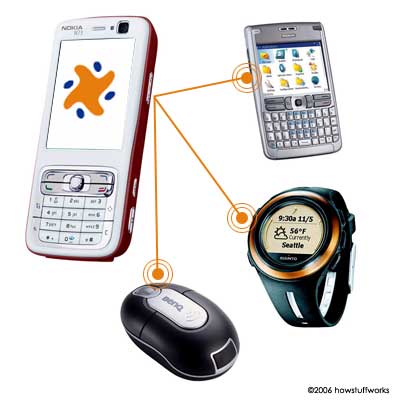What is Wibree Technology?
Wibree is a collection of protocols for short-range wireless communication. This technology is used to reduce the amount of energy used. This was created primarily for the sharing of Bluetooth data. This is a light-weight technology that, when combined with small transmitters and batteries, makes the entire device exceedingly light and portable.

Wibree, also known as Bluetooth Ultra Low Power, uses a fraction of the power of other radio technologies, making it easier to integrate with Bluetooth solutions and allowing for smaller and less expensive implementations.
History
The Nokia Research Center began developing this technology in 2001. This was done to reduce the amount of power used by mobile devices. In 2001, lowering the power consumption of mobile phones was a client requirement. It was created to provide consumers of this technology with low power consumption, small size, and low cost, as well as interoperability based on an open specification. It is a technology that utilises radio waves. It was rebranded as Bluetooth Smart in 2006.
It consumes less power, has a longer battery life, a smaller chip size, and is more energy-efficient than Bluetooth. It is simple to integrate into Bluetooth devices and to set up. It uses the same radio spectrum as Bluetooth, namely 2.4 GHz.
Wibree technology has a range of 200 metres. It operates at a speed of 1 Mbps. Wibree technology has a throughput of 0.2 Mbps. It isn’t equipped with a microphone. It works with a star-bus topology.
Wibree: Technical Specifications Wibree:
Technical Specifications Wibree: Technical Specifications
In many ways, Wibree is comparable to the widely used Bluetooth protocol. Both use the 2.45 GHz band to transmit data, with a 1 Mbps transfer rate (though the newer Bluetooth 2.0 standard currently has a 3.0 Mbps transfer rate) and a range of around 10 metres (m). The size, price, and, most importantly, power consumption of the two complimentary technologies varies. Wibree would utilise a quarter of the power that current Bluetooth chips do, resulting in significantly longer battery life and smaller gadgets.
While Bluetooth may be used to send audio and video files, Wibree was created to extend this network by serving applications that only send little quantities of data and prioritise size and cost. Many applications that were previously uneconomical to construct using conventional Bluetooth technology, such as wirelessly operated toys, watches, medical and sports sensors, and a variety of other yet-to-be-imagined applications, might be built utilising Wibree technology.
The fact that Wibree began as an alternate proposal for the radio and Media Access Controller (MAC) for the 802.15.4 standard, which is now the foundation of ZigBee and other short-range radio networks, is ironic.
A physical layer, a lightweight protocol stack, and application-specific profiles make up Wibree. It’s made to link mobile phones and computers to a variety of coin-cell battery-powered gadgets with long battery life. Nordic Semiconductor is a member of the Wibree specification committee and was one of the first companies to join the Wibree open effort. CSR, Broadcom, Epson, Suunto, and Taiyo Yuden are among the other members.
A short-range RF communication system with ultra-low power consumption, a lightweight protocol stack, and Bluetooth integration is described in the specification. Wibree uses the 2.4 GHz ISM (Industrial, Scientific, and Medical) band, which is widely approved. Over a range of 5 to 10 metres, it has a physical layer bit rate of 1Mbit/s. Dual-mode and stand-alone solutions are included in the specification. Wibree functionality is integrated into Bluetooth circuitry in the dual-mode implementation.
Wibree was created to complement and function with Bluetooth. It uses the 2.4 GHz ISM band and has a 1 Mbit/s physical layer bit rate. Devices such as wrist watches, wireless keyboards, toys, and sports sensors are among the most common uses, with low power consumption being a significant design requirement.
Wibree isn’t meant to replace Bluetooth; rather, it’s meant to complement it in approved devices. Wibree-enabled devices will be smaller and use less energy than Bluetooth-enabled ones. This is particularly relevant in wristwatches, where Bluetooth models may be too large and heavy to be comfortable. By replacing Bluetooth with Wibree, the gadgets will be smaller and lighter than current wristwatches.
Implementation
There are two ways to use Wibree technology:
1.Implementation in a single mode: These are fairly simple to set up. Low-energy implementation is achieved through single-mode implementation. This can be utilised in devices like heart rate monitors and other devices that require short messages and long battery life.
Watches, sports and wellness gadgets, and human interface devices (HID) such as wireless keyboards are examples of devices that would benefit from the Wibree stand-alone chip.
2. Dual-mode implementation: The Wibree technology is combined with Bluetooth technology to create a dual-mode implementation. This is designed to allow Bluetooth devices to use less energy.
Bluetooth devices employ the Bluetooth-Wibree dual-mode chip. Using core Bluetooth components and the existing Bluetooth RF, Wibree capability can be combined with Bluetooth for a minimal incremental cost in this type of implementation.
Bluetooth vs. Wibree
Wibree is distinct from Bluetooth in various aspects.
Data Transfer Speed: Recent Bluetooth specifications, particularly 2.0, place a premium on throughput, or the rate at which data is transferred. Under optimal conditions, Bluetooth 2.0 devices may reach rates of 350 kbps. This is around three times the maximum speed of Wibree devices, which can only transfer data at 128 kbps. In terms of power, space, and weight reductions, the tradeoff becomes clear. Current Bluetooth-enabled wristwatches require monthly battery replacements due to their big, specialised batteries.

Bluetooth uses frequency hopping to avoid interference from other devices that use the same frequency. Frequency hopping is not used by Wibree.
Packet Length: Bluetooth packets have a set length. As a result of the unneeded transmission, power consumption rises. Wibree uses a configurable packet length and only sends data when it’s needed.
Bluetooth drains your cell phone battery because it requires a lot of power to be active. Wibree aspires to last a year on a button-sized battery. When Wibree is not transmitting, it falls into sleep mode, unlike Bluetooth. The radio will be turned off in sleep mode, which will save a lot of power. Wibree devices only turn on when they wish to send data.
Traffic Characteristics: The traffic characteristics are the most significant distinction between Wibree and Bluetooth in terms of usage. Bluetooth is handy for exchanging files, using hands-free, and other situations where a large amount of data needs to be sent.
Wibree is utilised in situations when only short bursts of data are required to be communicated. Remote controls, sensor data, and so on.
Applications
- Wibree Technology is used in health, fitness, and wellness gadgets and gizmos.
- It’s a component of home automation systems, which are used in smart homes.
- Wibree technology is also found in office equipment.
- It’s also utilised in automatic timepieces, which makes them lightweight.
- It is used to reduce the power consumption of interactive toys.
- It is used in computers to reduce the amount of electricity they consume.
- Wibree is a wireless communication solution for high-performance PC accessories such as mouse, keyboards, and multimedia remote controls. Wibree’s ultra-low power consumption allows a battery life of over a year. Nordic will leverage its position as a leader in ultra-low-power 2.4 GHz technology to promote Wibree’s acceptance into PC accessories, paving the way for the next generation of wireless mice and keyboards.
- Mobile Phone Accessories — Wibree-enabled phones will be able to support a variety of new accessories, including call control/input devices, sports and health sensors, security, and payment devices. Wibree’s ultra-low power consumption will assist these devices, allowing for small, coin-cell battery-operated devices with battery lifetimes of up to three years (depending on the actual application).
- Watches – Imagine a watch with a wireless link that connects to a tiny sports sensor inserted in your shoe as well as your smartphone.
Wibree’s advantages over others Bluetooth
- Wibree is the first wireless technology that address all of the following requirements in one package.
- In both active and idle modes, the power consumption is quite low.
- Accessories and human interface devices are extremely low in cost and compact in size (HID).
- Mobile phones and computers benefit from a low-cost and small-size addition.
- Multi-vendor interoperability that is global, intuitive, and secure.
Wibree’s disadvantages over Bluetooth
- In comparison to Data transfer using Bluetooth is extremely sluggish, at only 1 megabit per second. Wibree also cannot be used in applications that require a lot of bandwidth.
- Wibree will also extend the battery life of existing wireless devices like as keyboards, mouse, and remote controllers significantly. It uses up to ten times less energy than Bluetooth. The first commercial version of the standard is scheduled to be ready in the second quarter of 2007, according to Nokia. Dual Bluetooth-Wibree products, such as cellphones, are expected to join the market within two years, according to the company.
Advantages
- Wibree technology consumes extremely minimal power.
- It is a cost-effective method.
- It works well across short distances.
- It has a lot of toughness to it.
- Wibree technology makes all connections incredibly simple and speedy.
Disadvantages
- Wibree technology transmits data at a snail’s pace.
- High-bandwidth devices are incompatible with this technology.
Conclusion
Wibree and Bluetooth both function at 2.4GHz and have a range of about 10 metres, but the difference between the two is in the data transfer continuity. Wibree is being marketed as being ideal for infrequent bursts of data — where the connected device will need to consume much less power. While Bluetooth is suited for constant uses such as streaming data or voice connectivity, Wibree is being marketed as being ideal for infrequent bursts of data — where the connected device will need to consume much less power.
Wibree radio technology complements other local connectivity technologies by requiring a fraction of the power of other radio technologies, allowing for smaller and less expensive implementations and easy Bluetooth integration.
Wibree is the first open technology to connect mobile devices or computers to small, button-cell battery-powered devices like watches, wireless keyboards, toys, and sports sensors. This technology improves the growth potential in various market areas by expanding the role mobile devices can play in customers’ lives.







